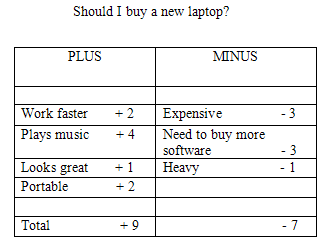Decision Making
Tools And Techniques
Decision making tools and techniques are often spoken about together, but here we will make a distinction.
Such things as visual aids and other helpful instruments are decision tools, and techniques are the processes used to arrive at a decision.
As such, decision making tools and techniques are not completely separate but can be used together in various combinations depending on what kind of result you are after.
Initially I will go into some depth on some of the decision tools, and techniques will be covered later.
A quick mention!
But first let me just mention these decision tools and techniques. Tossing a coin, cutting a deck of cards, tarot, astrology, runes, numerology and crystals. I know some people use these methods a lot and they are quite happy with them. However, there is also a lot to be said for learning to make your own decisions if you want to live your own life.
Decision making process games, however, can be fantastic tools to create experiences and skills in a safe environment.
Decision strategies may sometimes determine which decision making tools and techniques are best to use.
Computers and decision support systems
With the number of decision tools and techniques available, it's no surprise that programs have been written to help with the decision making process. These can be considered in three categories, decision making software, decision tree software and decision support systems (DSS).
DSS are computerised systems that collect, analyze and manipulate data to allow for problem analysis, strategy construction and decision making. For example, clinical decision support systems are used by doctors in diagnosis, investigation, treatment and long term care of patients.
Decision Tools
Many of the tools available to help with decision making take the form of charts or diagrams that you fill in with the information available to you. These visual decision tools are mostly used by people who like to have some visual representation of what's happening so they can get a 'clear view' of the situation! Decision wheels are one such example.Rules as tools...
Rule-based decision tools allow novices to make decisions like the pros by putting information into a predetermined format.
A simple T Chart
The idea here is to list the pros and cons of a particular decision, each list either side of the stem of a T. At it's simplest, if the list of pros is longer than the cons, go ahead. If the list of cons is longer, don't do it. Another variation would be to give each consequence a number depending on it's importance. The numbers in both columns are added and you go with the highest.
A decision making pros cons table might look like this:

Others...
Read here for details about other decision making tools and techniques such as PMI, decision making matrix, ORM, Kepner Tregoe and decision trees... and see some decision tree examples here...
A variety of techniques
By far and away the most popular decision making processes nowadays are the rational decision making models. These models use a rational, logical and sensible approach to making decisions. The decision making tools and techniques above are typical of rational decision making models.
The idea is to gather as much information as possible, analyze it, rationalise it and come up with the best solution. The decision making process steps are designed to do just this. And, of course, the more analytical and rational the model, the more the steps!
These decision tools and techniques are the main focus in our teaching establishments. Most probably because they are the most cognitive, that is, based in thinking and logic. And in Western culture we put a lot of importance on that.
Intuitive
The other major category is the group of intuitive decision making models. The process here involves using intuition or instinct. The exact process will vary depending on how intuition is defined. For some people, it's listening to their heart. For others, it's feeling with their gut, or accepting the visions, and so on.
To some extent, dowsing, tarot, astrology could be considered as intuitive decision making tools and techniques.
And, of course, there are combinations of both types.
More accurately...
Gary Klein, a psychologist, believes that people make up to 90% of their decisions in a distinctly different way. His recognition primed decision making model suggests that we don't actually do a comparison of options.
Rather we choose an option we think will work and do that. If it doesn't work, we choose another likely option and do that instead. He first described his recognition primed model in relation to critical decisions made by medical staff and firefighters. And he quickly realized that his description of our decision tools and techniques actually applies to everyday decisions as well.
Go to Decision Making Tools And Techniques - Part 2...
Like this page?
Mind Control
You have probably noticed that I am moving the whole Mind Control section to a new site. Please excuse any inconvenience.
This is the new site www.pschobegone.com. Feel free to come and visit. Any suggestions will be gratefully received!